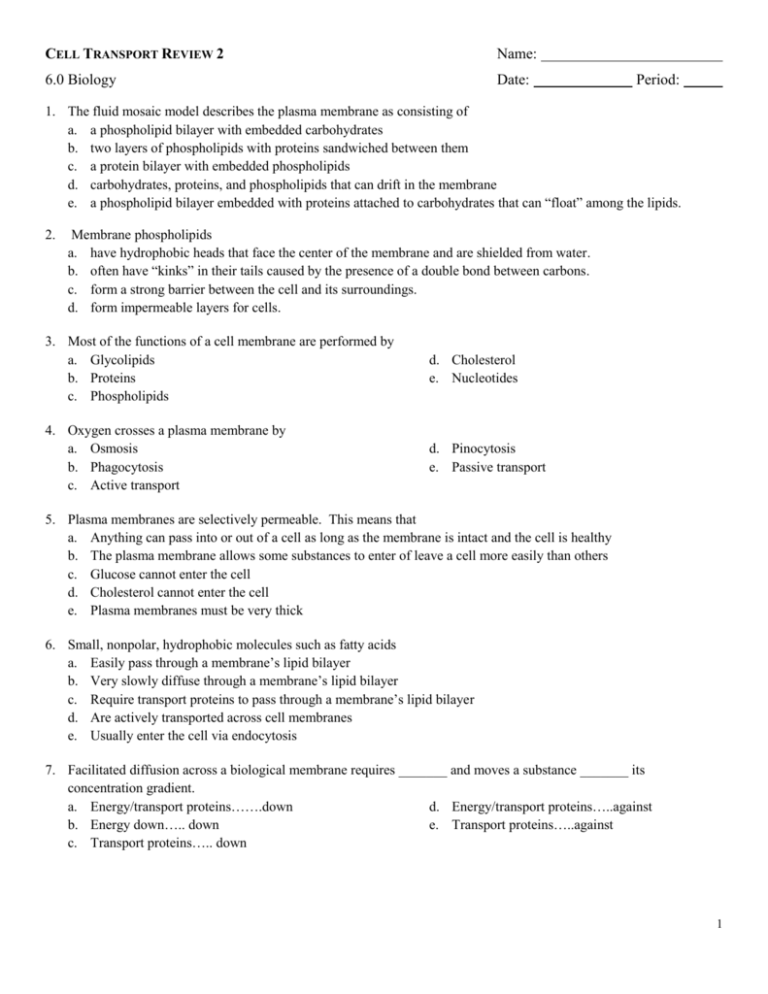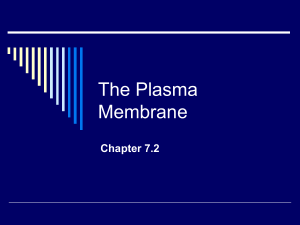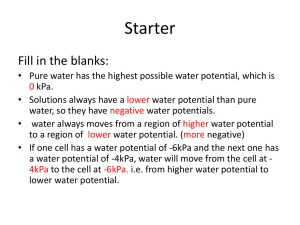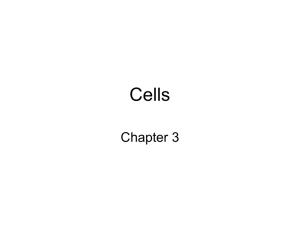Cell Transport Review 2
advertisement

CELL TRANSPORT REVIEW 2 Name: 6.0 Biology Date: Period: 1. The fluid mosaic model describes the plasma membrane as consisting of a. a phospholipid bilayer with embedded carbohydrates b. two layers of phospholipids with proteins sandwiched between them c. a protein bilayer with embedded phospholipids d. carbohydrates, proteins, and phospholipids that can drift in the membrane e. a phospholipid bilayer embedded with proteins attached to carbohydrates that can “float” among the lipids. 2. Membrane phospholipids a. have hydrophobic heads that face the center of the membrane and are shielded from water. b. often have “kinks” in their tails caused by the presence of a double bond between carbons. c. form a strong barrier between the cell and its surroundings. d. form impermeable layers for cells. 3. Most of the functions of a cell membrane are performed by a. Glycolipids b. Proteins c. Phospholipids d. Cholesterol e. Nucleotides 4. Oxygen crosses a plasma membrane by a. Osmosis b. Phagocytosis c. Active transport d. Pinocytosis e. Passive transport 5. Plasma membranes are selectively permeable. This means that a. Anything can pass into or out of a cell as long as the membrane is intact and the cell is healthy b. The plasma membrane allows some substances to enter of leave a cell more easily than others c. Glucose cannot enter the cell d. Cholesterol cannot enter the cell e. Plasma membranes must be very thick 6. Small, nonpolar, hydrophobic molecules such as fatty acids a. Easily pass through a membrane’s lipid bilayer b. Very slowly diffuse through a membrane’s lipid bilayer c. Require transport proteins to pass through a membrane’s lipid bilayer d. Are actively transported across cell membranes e. Usually enter the cell via endocytosis 7. Facilitated diffusion across a biological membrane requires _______ and moves a substance _______ its concentration gradient. a. Energy/transport proteins…….down d. Energy/transport proteins…..against b. Energy down….. down e. Transport proteins…..against c. Transport proteins….. down 1 8. In the lab, you use a special balloon that is permeable to water but not sucrose to make an “artificial” cell. The balloon is filled with a solution of 20% sucrose and 80% water and is immersed in a beaker containing a solution of 40% sucrose and 60% water. The solution in the beaker is ___________ relative to the solution in the balloon. a. Isotonic b. Hypertonic c. Hypotonic Which of the following will occur? a. water will enter the balloon b. water will leave the balloon c. nothing will occur d. water will enter and leave the balloon 9. Which of the following statements regarding diffusion is false? a. It is a result of kinetic energy of atoms and molecules. b. It is driven by concentration gradients. c. It requires no input of energy into the system. d. It occurs when particles spread from areas where they are less concentrated to areas where they are more concentrated e. It occurs even after equilibrium is reached an not net change is apparent 10. The diagram to the right represents a portion of a cell membrane. Which structure represents a hydrophobic region? a. Space between phospholipids b. Protein c. Phosphate head d. Fatty acid tails 11. Diffusion does not require the cell to expend any ATP. Therefore, diffusion is considered a type of a. Exocytosis d. Active transport b. Phagocytosis e. Endocytosis c. Passive transport 12. Which of the following processes could result in the net movement of a substance into a cell, if the substance is more concentrated in the cell than in its surroundings? a. Active transport d. Osmosis b. Facilitated diffusion e. Passive transport c. Diffusion 13. When physicians perform an organ transplant, they choose a donor whose tissues match those of the recipient as closely as possible. Which of the following cell components are being matched? a. Plasma membrane phospholipids d. Plasma membrane cholesterols b. Plasma membrane proteins e. Cytoskeletal elements c. Cell-surface carbohydrates 14. The diagram to the right shows the relative concentration of molecules inside and outside of a cell. Which statement best describes the general direction of diffusion across the membrane of this cell? a. Glucose would diffuse into the cell. b. Protein would diffuse out of the cell. c. Carbon dioxide would diffuse out of the cell d. Oxygen would diffuse into the cell. 2 15. In a hypotonic solution, an animal cell will a. Lyse b. Experience turgor c. Neither gain nor lose water d. Shrivel e. Lose water 16. You are adrift in the Atlantic Ocean, and, being thirsty, drink the surrounding seawater. As a result, a. You quench your thirst c. Your cells become turgid b. Your cells lyse due to the excessive intake of d. You dehydrate yourself salts e. Your cells lyse from excessive water intake 17. The diagram below represents movement of a large molecule across a membrane. Which process is best represented by this diagram? a. Active transport b. Diffusion c. Osmosis d. Protein building 18. The diagram on the right represents a cell in water. Formulas of molecules that can move freely across the cell membrane are shown. Some molecules are located inside the cell and others are in the water outside the cell. Based on the distribution of these molecules, what would most likely happen after a period of time? a. The concentration of O2 will increase inside the cell. b. The concentration of CO2 will remain the same inside the cell. c. The concentration of O2 will remain the same outside the cell. d. The concentration of CO2 will decrease outside the cell. 19. White blood cells are more resistant to lysis than red blood cells. When looking at a sample of blood for WBCs what could you do to reduce interference from RBCs? a. Mix the blood in a salty solution to cause the RBC’s to lyse b. Mix the blood in an isotonic solution and allow the WBCs to float to the top c. Mix the blood with a dye that stains the proteins in the cytoplasm d. Mix the blood with a hypotonic solution, which will cause the RBCs to lyse e. Mix the blood with a hypertonic solution, which will cause the RBCs to lyse 20. Activities in the human body are represented in the diagram to right. Which would be appropriate for the diagram? a. Rate of excretion varies in response to amount of water taken in b. Feedback mechanisms help to maintain homeostasis c. Respiratory rate responds to an increase in muscle activity d. The nervous system responds to changes in blood sugar levels 3 21. The function of the white blood cells in your body is to find and digest invading bacteria cells. The diagram below shows how the white blood cells ingest the invading bacteria cells. Name and explain the process. 22. Paramecium is a single celled eukaryotic organism that lives in freshwater ponds. Paramecia have an organelle that many cells do not have called a contractile vacuole. The function of the contractile vacuole is to collect excess water that moves into the cell. Once the contractile vacuole is full, the water is pumped out of the cell. a. Which process (diffusion, osmosis, or active transport) causes the water molecule to move from the environment to the inside of the cell? Explain. b. Which process causes the water molecules to move from the inside to the outside environment? Explain. c. What would happen to the paramecium if the contractile vacuole stops functioning? 23. The 4 plant cells below were placed into different salt solutions. One was placed into a 1% salt solution. One in a 3% salt solution. One in a 5% salt solution. One in a 10% salt solution. a. Which cell was most likely placed into the 5% salt solution? b. In which cell has plasmolysis occurred? Why did plasmolysis occur in this cell? c. What salt solution is isotonic compared to the original cell? d. Which cell has the greatest amount of turgor pressure?? In which salt solution was this cell placed? 4 5








